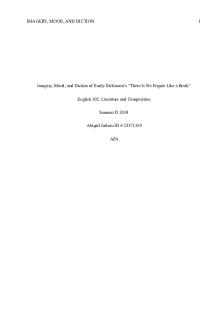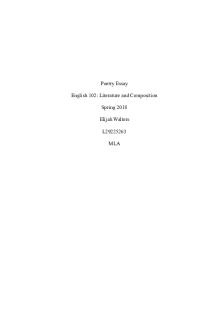Chimney Sweeper Poetry Essay PDF

| Title | Chimney Sweeper Poetry Essay |
|---|---|
| Author | Fynn Jacobsen |
| Course | Composition I |
| Institution | University of Hawaii at Manoa |
| Pages | 4 |
| File Size | 79.5 KB |
| File Type | |
| Total Downloads | 82 |
| Total Views | 135 |
Summary
Analysis of the chimney sweeper ...
Description
Fynn Jacobsen 4/10/18 English 102 Poetry Essay Juliann Reineke
Smokestack Cleaner “The Chimney Sweeper”, written by William Blake, is a poem about a young boy who is sold into the chimney cleaning business by his father after his mother had died. To survive, the young boy is forced to find work constantly and spend his nights sleeping on bags of soot which he complied from cleaning chimneys. Though he works strenuously, he cannot seem to dodge his misfortunes or overlying opinions of others. From reading the poem, the reader quickly connects with the boy and becomes aware of societies’ negative viewpoint of people that they consider to be “lesser”. Through a powerful set of contrasts which are closely related, Blake works to help expose the underlying theme of social injustice and criticism throughout the poem. The overlying contrast of this poem is between experience and childhood innocence. “Usually the condition of childhood, innocence is that state in which evil is not known; it is characterized by joy and love, is normally associated with the peaceful harmony of a pastoral background…” (Mellown). Experience on the other hand, “brings awareness of evil; it is accompanied by feelings of outrage and hatred; and it finds its appropriate setting in the city” (Mellown). The unfortunate events of the young boy’s mother passing away, his father selling him as a worker, and him needing to take care for himself, completely deprived the boy of his innocence and led him on a journey of experience instead. Though this is true, the boy does not show signs of protest, continues working, and accepts the general fact that it is a corrupt adult world. “Blake makes a passionate indictment of a society that exploits the weak and at the same
time hypocritically uses moral platitudes about duty and goodness to further its selfish interests” (Mellown). As the poem progresses, the story makes a quick interchange of emphasis from the narrator (the young boy) and his friend, Tom Dacre. Though the boy’s circumstances are less than ideal, he is quick to show sympathy and care towards Tom who cried when he had his hair “shav’d” (Blake). One night when Tom goes to sleep, he has a dream. “He sees thousands of sweepers, all lock'd up in coffins of black” (Mason). Subsequently, they are released by an Angel to enjoy themselves and play on a heavenly plane. This dream symbolizes the obstructed working environment in which they lie, and strongly supports the idea of social injustice and criticism. In addition to this, the reader becomes aware of how strong the young boy is for persevering past his difficult misfortunes yet continuing to have the “innocent” mindset. “His is a naive and accepting innocence that never seeks to question or challenge the social conditions that keep him, and others like him, bonded and begrimed in cruel and perilous labour” (Mason). The Angel freeing the sweepers in addition to the young boy maintaining his “innocent” mindset, could mean that there is something positive in the boys’ future. By providing the reader with given contrasts, specific images gain symbolic importance. Because these images include contrasts such as those between innocence and experience, they strongly support the underlying theme of social injustice. With care for others and an open mindset, the boy is restricted by his environment and past, yet still has great potential for success in his future. To fuel this, Tom’s mystical dream might just bring the duo enough luck to provide them a different opportunity than that of sweeping chimneys.
Works Cited -
Blake, William. “The Chimney Sweeper”. Songs of Innocence, 1789
Mellown, Muriel. “ The Chimney Sweeper”. Salem Press, 2002
Mason, Diane. “The Chimney Sweeper”. Encyclopedia of Literary Romanticism 2nd Edition, 2014
Outline – Indroctuction –
Give foundation of poem – plot, setting, main character
Discuss misfortunes, give more background information
Introduce thesis - Through a powerful set of contrasts which are closely related, Blake works to help expose the underlying theme of social injustice and criticism throughout the poem.
Body 1 –
Expand of previous statements – use of contrast to show injustice in society
What kind of contrasts? o Innocence o Experience
How does this reinforce the thesis?
What are the outcomes of this contrast?
Body 2 –
Show different analyzation of social injustice – black coffins
Resiliency and strength of the young boys – maintaining positive mindsets
Possibility in bright futures – Angel saving them
Conclusion –
Reiterate previous remarks – contrast, imagery
Support thesis
Form of hope for the boys – bright futures...
Similar Free PDFs

Chimney Sweeper Poetry Essay
- 4 Pages

Poetry Essay - Grade: A+
- 5 Pages

Poetry Analysis Essay Examples
- 7 Pages

Essay Blazon poetry
- 2 Pages

Essay Poetry - Grade: A
- 3 Pages

Poetry Essay - Grade: 80%
- 6 Pages

Poetry Essay - Grade: B
- 5 Pages

Poetry essay- Warming Her Pearls
- 4 Pages

Poetry essay works cited info
- 2 Pages

Poetry
- 21 Pages
Popular Institutions
- Tinajero National High School - Annex
- Politeknik Caltex Riau
- Yokohama City University
- SGT University
- University of Al-Qadisiyah
- Divine Word College of Vigan
- Techniek College Rotterdam
- Universidade de Santiago
- Universiti Teknologi MARA Cawangan Johor Kampus Pasir Gudang
- Poltekkes Kemenkes Yogyakarta
- Baguio City National High School
- Colegio san marcos
- preparatoria uno
- Centro de Bachillerato Tecnológico Industrial y de Servicios No. 107
- Dalian Maritime University
- Quang Trung Secondary School
- Colegio Tecnológico en Informática
- Corporación Regional de Educación Superior
- Grupo CEDVA
- Dar Al Uloom University
- Centro de Estudios Preuniversitarios de la Universidad Nacional de Ingeniería
- 上智大学
- Aakash International School, Nuna Majara
- San Felipe Neri Catholic School
- Kang Chiao International School - New Taipei City
- Misamis Occidental National High School
- Institución Educativa Escuela Normal Juan Ladrilleros
- Kolehiyo ng Pantukan
- Batanes State College
- Instituto Continental
- Sekolah Menengah Kejuruan Kesehatan Kaltara (Tarakan)
- Colegio de La Inmaculada Concepcion - Cebu





